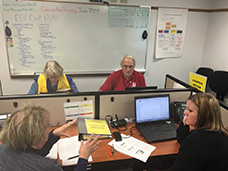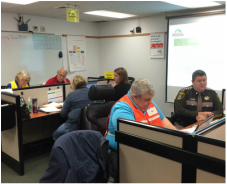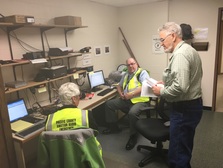Response
Pacific County Emergency Management Agency
What is an Emergency Operations Center?
Or EOC as its commonly called? An accurate description of an EOC among emergency managers nationally is that it is a location “Where uncomfortable officials meet in unfamiliar surroundings to play unaccustomed roles, making unpopular decisions based on inadequate information, in much too little time.”
The Pacific County EOC is that geographical space designated for the primary purpose of facilitating the management (i.e., strategic operations, away from site) of an emergency incident or a disaster event. The space could be just about anything (e.g., a building, tent complex, ship or air-board, or virtual) and may be placed anywhere, as long as it is distinct from the operations at the emergency site. Smaller emergencies are managed at a Command Post on site of the incident. In contract, incidents of a larger scale (possibly involving the entire county) typically involve diverse jurisdictions or areas of responsibility.
It is important to note that any emergency may involve a variety of EOCs, each responsible to a separate entity (i.e., public, private, or Community-Based Organization). Pacific County for example, has an “alternate EOC” in the south county facility. Inevitably, the EOC that is operated by the agency with the ultimate jurisdiction over the affected area will become the key or lead EOC. Leadership in the EOC is dependent upon the nature of the incident. A community-wide health crisis, for example, would be led by the County Health Officer, while a community-wide evacuation may be directed by the county Sheriff. PCEMA staff fill the role of “EOC Manager”, serving to facilitate and plan for EOC staffing and support of any incident.



Community Emergency Response Team (CERT)
CERT educates individuals about disaster preparedness for hazards that may impact their area and trains them in basic disaster response skills, such as fire safety, light search and rescue, team organization, and disaster medical operations. Using training learned in the classroom and during exercises, CERT volunteers can assist others in their community following a disaster when professional responders are not immediately available to help.
If you would like to know more about how to get involved with CERT or to find out when the next class is, contact the PCEMA office.
American Red Cross Cascades Region
The American Red Cross prevents and alleviates human suffering in the face of emergencies by mobilizing the power of volunteers and the generosity of donors. Each year, the American Red Cross responds to nearly 70,000 natural and man-made disasters in the United States, ranging from fires to hurricanes, floods, earthquakes, tornadoes, hazardous materials spills, transportation accidents and explosions. In Oregon and Southwest Washington, Red Cross volunteers respond twice a day to such disasters.
Red Cross disaster relief focuses on meeting people’s immediate emergency needs caused by disaster. The Red Cross provides shelter, food, and health and emotional health service to address basic human essentials, and assist individuals and families in resuming their normal daily activities independently. The Red Cross also supports emergency first responders including fire fighters and police in cases of special need such as a search and rescue. Our volunteers handle inquiries from concerned family members outside the disaster area, provide blood and blood products to disaster victims, and help people affected by disaster access other available resources.
To learn more about the Red Cross’ disaster services, visit their website.




